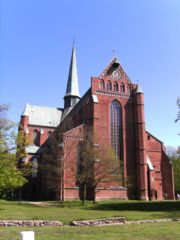
Doberan Abbey
Encyclopedia

Bad Doberan
Bad Doberan is a town in the district of Rostock, Mecklenburg-Vorpommern, Germany. It was the capital of the former district of Bad Doberan. As of 2010 its population was 11,325.-Geography:...
, Mecklenburg-Vorpommern, Germany
Germany
Germany , officially the Federal Republic of Germany , is a federal parliamentary republic in Europe. The country consists of 16 states while the capital and largest city is Berlin. Germany covers an area of 357,021 km2 and has a largely temperate seasonal climate...
. The church continues in use as Doberan Minster (Doberaner Münster).
After the conversion to Christianity of the Wendish
Wends
Wends is a historic name for West Slavs living near Germanic settlement areas. It does not refer to a homogeneous people, but to various peoples, tribes or groups depending on where and when it is used...
prince Pribislav
Pribislav of Mecklenburg
Pribislav was an Obotrite prince and the first Prince of Mecklenburg .Pribislav was one of three sons of the Obotrite chieftain Niklot, who was killed in 1160 during a joint campaign by Duke Henry the Lion of Saxony and King Valdemar the Great of Denmark...
, Doberan was the first monastery founded in Mecklenburg
Mecklenburg
Mecklenburg is a historical region in northern Germany comprising the western and larger part of the federal-state Mecklenburg-Vorpommern...
, in 1171, as a daughter house of Amelungsborn Abbey
Amelungsborn Abbey
Amelungsborn Abbey, also Amelunxborn Abbey near Negenborn and Stadtoldendorf, in the Landkreis of Holzminden in the Weserbergland, was the second oldest Cistercian foundation in Lower Saxony, Germany, after Walkenried Abbey...
. The first community, at Althof, was massacred in 1179 in the unrest following the death of Pribislaw, and the abbey was re-founded in 1186 in Doberan. It quickly became a political, social and spiritual centre in the region. The abbey church, which continues in use as Doberan Minster (Doberaner Münster) , is one of the most important Brick Gothic
Brick Gothic
Brick Gothic is a specific style of Gothic architecture common in Northern Europe, especially in Northern Germany and the regions around the Baltic Sea that do not have natural rock resources. The buildings are essentially built from bricks...
buildings in Mecklenburg-Vorpommern. Until the Reformation
Protestant Reformation
The Protestant Reformation was a 16th-century split within Western Christianity initiated by Martin Luther, John Calvin and other early Protestants. The efforts of the self-described "reformers", who objected to the doctrines, rituals and ecclesiastical structure of the Roman Catholic Church, led...
, during which it was secularised in 1552, the abbey possessed great estates, and was the burial place of the Princes of Mecklenburg.
The premises were badly damaged in 1637 during the Thirty Years' War
Thirty Years' War
The Thirty Years' War was fought primarily in what is now Germany, and at various points involved most countries in Europe. It was one of the most destructive conflicts in European history....
, when the minster was used as a storage depot, and some buildings were destroyed. During the French occupation of Mecklenburg under Napoleon from 1806 to 1813 more damage was sustained, and the church was again used as an ammunition dump. Between 1883 and 1896 the church was "restored" in an inappropriate 19th century Gothic Revival style, which was undone in a further restoration in the 1960s and 1970s.

